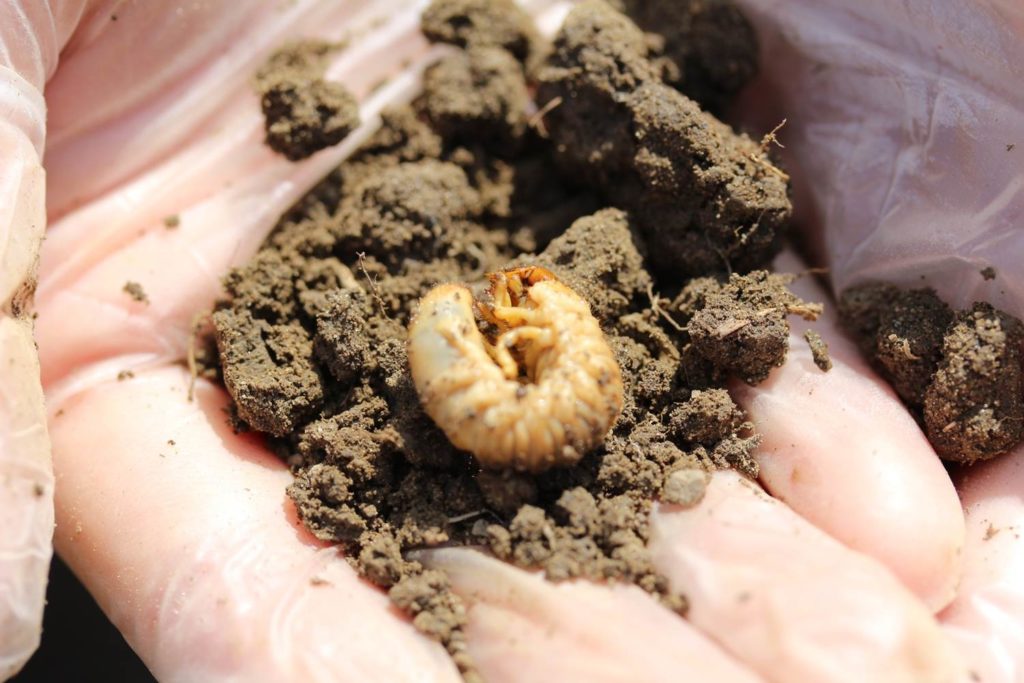Grubs (European chafer, June beetle or Japanese beetle)
Various types of grubs can attack field crops, primarily corn, soybeans, forages and winter cereals. European chafer and June beetle are the most common problem grubs in Ontario field crops, although Japanese beetle grubs can also cause damage. Proper identification of the species of grub present in each field is important, as their life cycles are different, which influences the management strategies implemented. Consult the OMAFRA Agronomy Guide for Field Crops for more information on specific grub species.
Description
Grubs are white and C-shaped larvae, with an orange-brown head and dark posterior. When walking, they drag their posterior along the ground. Correctly identifying the species of grub requires using a hand lens focused on the anal bristles known as “rasters” that are positioned on the underside, at the last abdominal segment of the larva (posterior). Each species has a particular raster pattern. Identifying the species will determine when feeding activity is expected, how long they will remain in the soil and when control measures can be implemented.
Damage
Grubs feed on the fibrous roots 3–5 cm (1–2 in.) from the soil surface. Roots are pruned, causing plants to become stunted and eventually wilt. Intense root feeding results in poor emergence and plant death. Crop damage is dependent on the timing of planting and crop emergence in relation to larval feeding activity. If the crop is planted after the grub species has completed its larval stages (feeding stage of the insect), crop damage can be avoided. Additional damage can occur from predators such as skunks and raccoons that dig up and feed on the grubs, although the damage seldom causes economic yield loss.
Conditions that Increase Risk
Fields with sandy or silty knolls and in areas close to treelines are prone to more egg laying. Fields following soybeans, alfalfa, sod, pasture cereals and potatoes are at higher risk. Susceptible crops grown adjacent to pasture, sod farms, parkland and golf courses are particularly prone to grub infestations.
Scouting Technique
Fall is the best time to scout for grubs, though spring scouting before or after planting is also possible. Soil temperatures and grub life cycle determines when each grub species is feeding at the soil surface. See life cycle sections under each grub species in the OMAFRA Agronomy Guide for Field Crops to properly target scouting.
Scout for grubs on the sandier knolls of fields, areas near treelines and in areas where past or current injury was/is evident. Using a shovel, dig up approximately 30 cm2 (1 ft2) of soil, roughly 7.5–10 cm (3–4 in.) deep, in at least five areas of the field. Sift through the soil by hand, breaking up any clumps, and count how many grubs are found in each sample. If the crop has already emerged, find areas of the field where there are gaps in the stand or wilting seedlings. Go to the next nearest surviving plant and dig up those roots to find any actively feeding grubs.
Threshold
There may be specific guidelines and scouting techniques required to access neonicotinoid treated seed in Ontario, which are not described here. If grub populations are high (four or more larvae per 30 cm2 (1 ft2)), use the higher rate of an insecticide seed treatment. For other control options, the presence of two or more larvae per 30 cm2 (1 ft2 ) indicates the need for control measures.
Management Strategies
- Cultural options include disturbing the soil by tillage or disking (at least three passes), which brings the grubs to the surface where they are exposed to the elements and natural enemies such as birds, skunks and raccoons. For this strategy to be effective, plow in the fall before the grubs migrate below the plow depth.
- Plant crop into ideal soil conditions so the crop will rapidly become established and able to tolerate low to moderate grub feeding.
- Use an insecticide seed treatment or soil-applied in-furrow insecticide on those crops with products available. In Ontario, the use of neonicotinoid seed treatments may be restricted.
- Avoid planting forages or other susceptible crops that lack an insecticide seed treatment or soil applied option in fields with a known history.
- Some predators, parasitoids and pathogens can help to reduce grub populations if conditions are ideal, though they are not comparable to a chemical control option.
- No rescue treatments are available.
Dr. Art Schaafsma, University of Guelph, is acknowledged for his contributions to this content.
